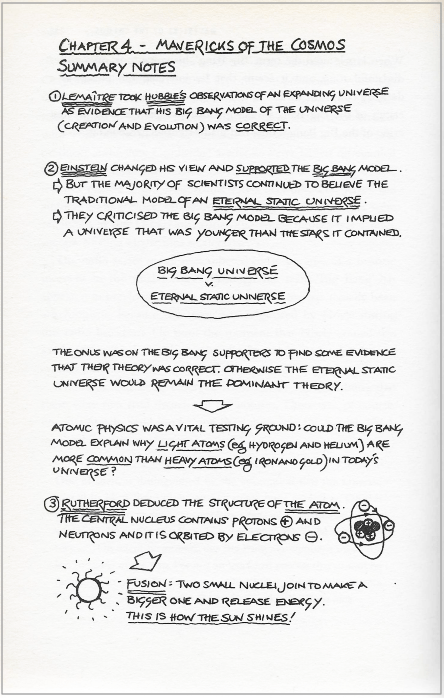Examples of multi-level content – Part 3
Simon Singh‘s 2004 book Big Bang: The most important scientific discovery of all time and why you need to know about it provides an interesting example of multi-level content.
Science writer Singh has written a 532-page history of the investigation into the origins of the universe. In the book, he provides two levels of content:
- the conventional detailed explanation
- two-page handwritten and hand-drawn summaries for each of the chapters.
Below is the summary for Chapter 4.
While some non-fiction writers do provide chapter summaries, Singh’s approach is unusually powerful:
- The handwritten text along with the hand-drawn diagrams and icons make the summaries stand out from the typeset text.
- The linking of text blocks by the use of vertical arrows makes the progression of knowledge more obvious.
- The use of text within ovals highlights the key themes eg. Big bang universe v. steady state universe.
- Singh is very good at compressing dense knowledge into understandable and informative summaries.
Comments from Amazon reviewers
Comments from reviewers of the book on both Amazon US and Amazon UK show the popularity of Singh’s summaries:
“At the end of each chapter you get a wonderfully illustrated and condensed summary that allows you to solidify the knowledge gained before going on to the next chapter, as well as allowing you to go back to this book and refreshing your memory.” Spider Monkey
“This is also the best example of [the] art of summarising material that I have ever seen – each chapter of around 80 pages is summed up in 2 sides of notes – without losing anything.” R.C. Lucas
“I also have to mention the little recaps/summaries at the end of every chapter, which I think are great and function as perfect refreshers before moving on to the next chapter, as well as months after finishing the book.” S.K.
“Each chapter is summed up in two surprisingly helpful pages of notes.” Steve
“The most important aspect of the book is that each chapter contains a valuable handwritten and annotated summary with diagrams that can be used to further consolidate one’s understanding by visualizing the diagrams, as a way to peek ahead, or to skip interim chapters to more quickly get to the meaty portions of the book. I have used the chapter headings and those summaries as a guide to writing the rest of this review.” Herbert L Calhoun
“The chapters are very long, but a short notes summary at the end of each prevents the reader losing the storyline.” Mr P R Morgan
“At the end of each chapter he provides an excellent synopsis of the state of affairs in clear hand-written notes.” chiplatt
“The two page summaries at the end of each chapter are a great way to recap the events discussed at length in the chapter.” Tushar Rane
The benefits of summaries
These comments illustrate some of the benefits of chapter summaries. They allow readers to:
- have a recap of what they have just read before they move on to the next chapter
- revisit the book months after they have finished it and quickly re-acquaint themselves with the key ideas
- get an understanding of the framework and themes of each chapter before they have to dive in to the detail
- keep themselves orientated to the big picture as they read through a long and complicated book
- quickly identify the parts of the book that are of most interest to them
- write about the key themes of the book without needing to do a huge amount of summarising work themselves.
Other books that include multi-level content
If you would like to read about other books that include multi-level content, please look at the following blog posts:
Christopher Alexander’s use of multi-level content
Andrew Abela’s Advanced Presentations by Design
H/t: Jérémie Pottier who suggested Big Bang in reply to Tiago Forte’s tweeted question asking for details of authors who provide chapter summaries/outlines etc to help readers navigate books.







